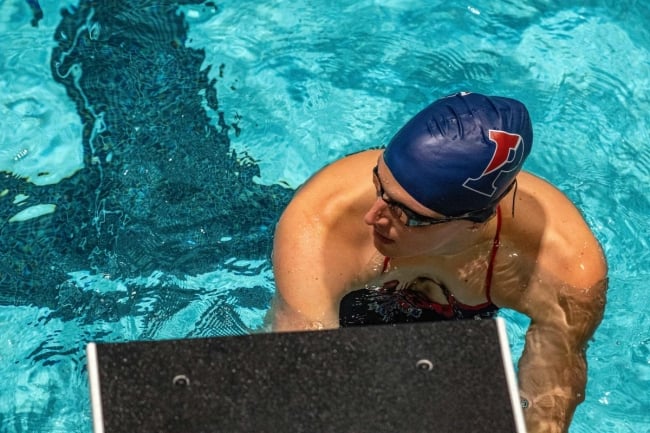You have /5 articles left.
Sign up for a free account or log in.

After a dominant year, Lia Thomas will compete in the last meet of the regular season Friday.
Joseph Prezioso/Getty Images
All Lia Thomas wants to do is swim.
To her supporters, this is a revolutionary act; the transgender student athlete competing on the women’s swim team at the University of Pennsylvania is a role model, breaking barriers—and NCAA records. To her many detractors, however, Thomas’s success signals the looming death of women’s sports, as transgender athletes supposedly invade and corrupt the purity of such competitions.
To the greater sports world, Thomas represents something entirely different: a challenge in thinking about competition in a new era where gender is seemingly as fluid as the pools Thomas has dominated since joining the Penn women’s swim team this season, greatly surpassing the success she previously experienced in three years competing on the men’s team.
Thomas has complied with NCAA rules. After not competing in the 2020–21 season—which the Ivy League canceled because of the COVID-19 pandemic—Thomas met the NCAA requirement that transgender athletes complete a year of testosterone-suppression treatment before competing in the women’s division of a sport. Nonetheless, many see Thomas as an unwelcome entrant into women’s sports. Now the sports world is grappling with how to handle the most visible transgender athlete in years amid questions of fairness as she dominates the swim lanes.
Heading into the last week of the regular swim season, Thomas is bringing widespread attention to an often-overlooked sport.
Thomas declined to speak with Inside Higher Ed, and Penn chose not to make any officials available for an interview, though the university has previously signaled support for Thomas.
The Question of Fairness
For every win Thomas racks up, it seems she gains critics. Teammates have taken swipes at her in anonymous interviews, swimming publications have declared her physical attributes akin to doping and a swimming coach at Franciscan University of Steubenville called for colleges to defend women’s sports by rejecting trans athletes.
Cynthia Millen resigned after 30 years as a USA Swimming official to protest Thomas’s participation in women’s swimming, which she sees as fundamentally unfair. Thomas's long body and larger hands and feet are physical attributes that set her apart from other competitors in the women’s division, she said. She argues that those physical features can’t be undone with testosterone suppression.
“The advantage is never going to be taken away,” Millen said. “Bodies swim against bodies, and Lia Thomas has a male body.”
Even so, she doesn’t necessarily blame Thomas for the controversy. The fault, she says, lies with governing bodies.
“What this says to women is that you don’t matter,” Millen said. “It’s very selfish, in my opinion, of Lia, but it’s not Lia’s responsibility. It’s the NCAA’s responsibility and USA Swimming’s responsibility to say, ‘This doesn’t work, this isn’t fair, you can only compete in your biological sex.’”
Others, however, see such criticism as an expression of rigid and outdated gender binary constructs.
Travers, a sociology professor at Simon Fraser University who uses a single name and they/them pronouns, has studied transgender participation in sports since their pretransition days competing in a lesbian softball league. When transgender participants wanted to join, Travers looked into how other leagues were approaching this issue, thus launching a long-term academic interest.
To Travers, gender inequality is normalized and persistent in a sports world “built on a faulty edifice, on the basis that there are only two sexes, and that men and women are profoundly different.” Travers also sees the dozens of bills being introduced in state legislatures to ban transgender participation in sports as a brazen power play from right-wing politicians.
“Transgender athletes are a wedge issue,” Travers said. “They’re using transgender athletes to stoke a moral panic, which is a way of shifting public support. They’re trying to electrify and build their base.”
Despite the sharp disagreements between supporters and detractors of trans athletes, Millen and Travers agree on one thing: that the recently updated NCAA guidance for trans athletes is wholly inadequate. Both believe that the new policies—which grant more autonomy to individual sports to set their own policies or to defer to existing policies from international governing bodies—mean the NCAA essentially punted on the issue of trans athletes by refusing to take a strong stand and simply kicking the can down the road.
The NCAA did not respond to a request for comment on its policies for transgender athletes.
What the Research Says
Maybe transgender women who have transitioned have an athletic advantage over cisgender women, or maybe they don’t; it all depends on which research one reads. And experts say that there simply isn’t enough research on the subject to draw definitive conclusions on performance.
Joanna Harper, a visiting fellow for transgender athletic performance and Ph.D. student at Loughborough University in the U.K., said it will be “decades before there’s definitive research on trans athletes.” Harper, however, is among the first to study the issue, inspired by her own declining performance as a long-distance runner after she transitioned.
Harper followed up on her observation with research, releasing a 2015 study that found transgender distance runners did not have an advantage over cisgender women.
“Trans women in the study got substantially slower after starting hormone therapy,” Harper said. “Trans women were no more competitive in the women’s division after hormone therapy than they had been in the men’s division prior.”
By contrast, a 2021 study that looked at transitioning members of the U.S. Air Force found that transgender women did have an athletic edge over their cisgender female peers in physical training.
Christina Roberts, adolescent medicine fellowship director at Children’s Mercy Hospital in Kansas City, Mo., conducted the research during her time in the Navy, noting in an email that transitioning service members wanted to know what changes they could expect as they transitioned and how it might affect their performance on a physical fitness test. In the absence of this data, Roberts, who is transgender, says she and others tracked their physical performance and found that trans women outperformed cisgender women, suggesting an ongoing advantage linked to testosterone.
Even after a year of testosterone suppression, a strength advantage remained. Now Roberts suggests that allowing competition after two years of testosterone suppression may be a better solution than the NCAA’s current one-year policy, though she notes that while strength declined, transgender women in the Air Force also had better running times than cisgender women after two years of hormone treatment. The study did not assess physical changes beyond the two- to two-and-a-half-year mark.
Until this month, NCAA rules required transgender athletes to undergo one year of testosterone suppression before competing on women’s teams. A policy update, going into effect ahead of the 2022 winter championships, now requires trans athletes “to document sport-specific testosterone levels beginning four weeks before their sport’s championship selections,” per the NCAA website. Additionally, as of the 2022–23 academic year, trans athletes must document testosterone levels at the start of the season and then again six months later. “They will also need documented testosterone levels four weeks before championship selections,” the NCAA notes.
But what’s good for elite athletics, such as the NCAA, may not matter as much at lower levels of competition, despite the political appetite in some circles for banning transgender athletes from participating in women’s sports.
“This advantage probably does not matter at the youth and high school level, where there are large differences in training, facilities and equipment between athletes,” said Roberts. “However, this advantage may be important in some sports at the elite level, where the differences between competitors are smaller.”
Research has also been conducted specifically on Lia Thomas’s performance. A study by researchers from the Mayo Clinic, Duke University and Marquette University found that swim times for Thomas were about 5 percent slower this season than when she competed on the men’s team.
“These findings add to the substantial evidence showing that testosterone is strongly associated with sex-based differences in sports performance,” Jonathan Senefeld, a research fellow at Mayo Clinic Rochester, wrote in an email. “These data may help provide a framework for regulators considering participation guidelines for transgender athletes in the female category.”
Ultimately though, all researchers suggest many more studies need to be conducted.
The Future for Trans Athlete Participation
To Roger Pielke Jr., a professor and former director of the defunct Sport Governance Institute at the University of Colorado at Boulder, the controversy over Thomas is simply a classification issue.
And in the sports world, classification issues are constant.
“Who gets to compete under what flag?” Pielke asked, as one example. “Can amputees run on prostheses in the Olympics? What age limit should we have for girls’ gymnastics? What substances are allowed in the human body and you can still be eligible to compete?”
Rather than create broad-brush policies that affect all transgender athletes, Pielke suggests a more nuanced approach that takes the attributes of individual athletes into consideration. He also encourages a sport-by-sport approach. Boxing and gymnastics are not the same, after all.
Harper suggests the solution to these issues is not found in the extremes but remains rather complex.
“There are good reasons why we have women’s sports and why we separate male athletes from female athletes,” she said. “If we want to help women win Olympic gold medals, earn professional sports contracts, there does need to be a female category. We need eligibility rules that make sense. It is certainly true that on average, trans women will be taller, bigger and stronger than cis women, even after hormone therapy. So there’s some validity for concern.”
Even as a transgender woman, Harper supports “reasonable restrictions” on trans athletes. But those restrictions should come at higher levels, where prize or scholarship money is involved.
“At high levels of a sport, I think restrictions are important,” Harper said. “For starters, we should require trans women to maintain low testosterone before and during periods of competing in the women’s category. Beyond that, there may need to be further restrictions in certain sports.”
The sports world, like society, is in a constant state of change. As the game evolves, so do the rules. Now social progress is colliding with the status quo of collegiate athletics, and experts say governing bodies need to approach this issue carefully rather than abdicate responsibility.
“Sport doesn’t exist in a vacuum,” Pielke said. “And if society—and by society, I mean the majority of countries around the world—have determined that it is legal for genders to be changed, then sport has to figure out a way to accommodate that. We can’t say, ‘No, we don’t want to be part of that.’ That’s just not an option in modern society.”
Ultimately, the presence of Thomas in the pool reflects sports as a microcosm of society.
In framing Thomas’s success and the fear over a future of transgender dominance of women’s sports, Harper turns to history and math to suggest the concerns are overblown.
First, she points to Hannah Mouncey, who played on the Australian women’s national handball team in 2018 after transitioning. Critics voiced the same concerns about Mouncey that they do about Thomas, yet in the end, while Mouncey was among the best players on the Australian women’s handball team, the team itself was midtier. And just as Mouncey has been forgotten by many, so will Thomas, Harper suggests.
Secondly, transgender people comprise a tiny fraction of the U.S. population and an even smaller proportion of NCAA athletes. Among more than 200,000 female student athletes in the NCAA, the number of trans competitors is minimal, Harper said: “Ten years after the NCAA put in rules to allow trans women to compete based on hormone therapy, trans women are not taking over the NCAA and are still hugely underrepresented in this very large population.”
As for a future where trans competitors dominate women’s sports? The math, she said, just doesn’t add up.






_edit.jpg?itok=d3X97aqv)

